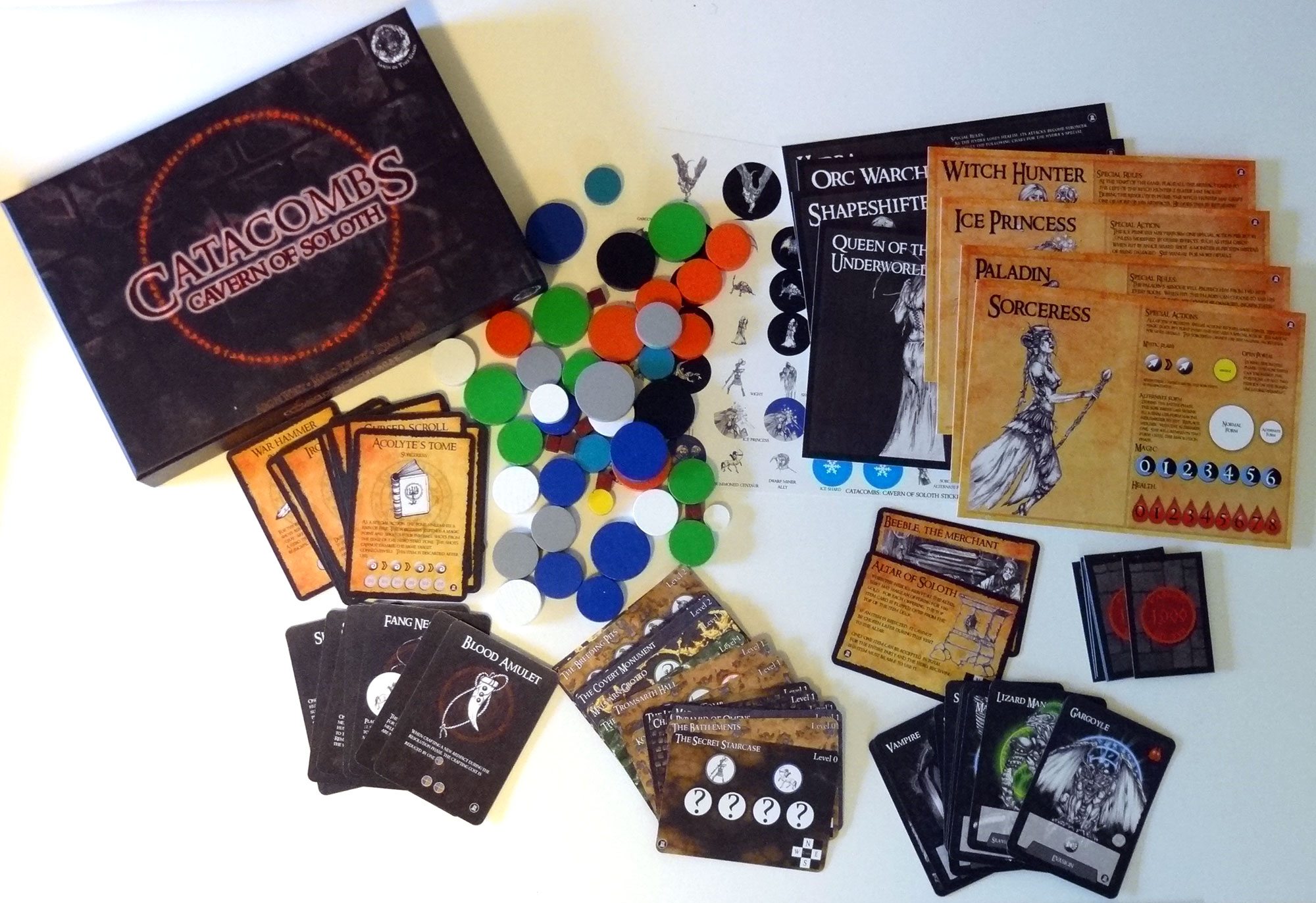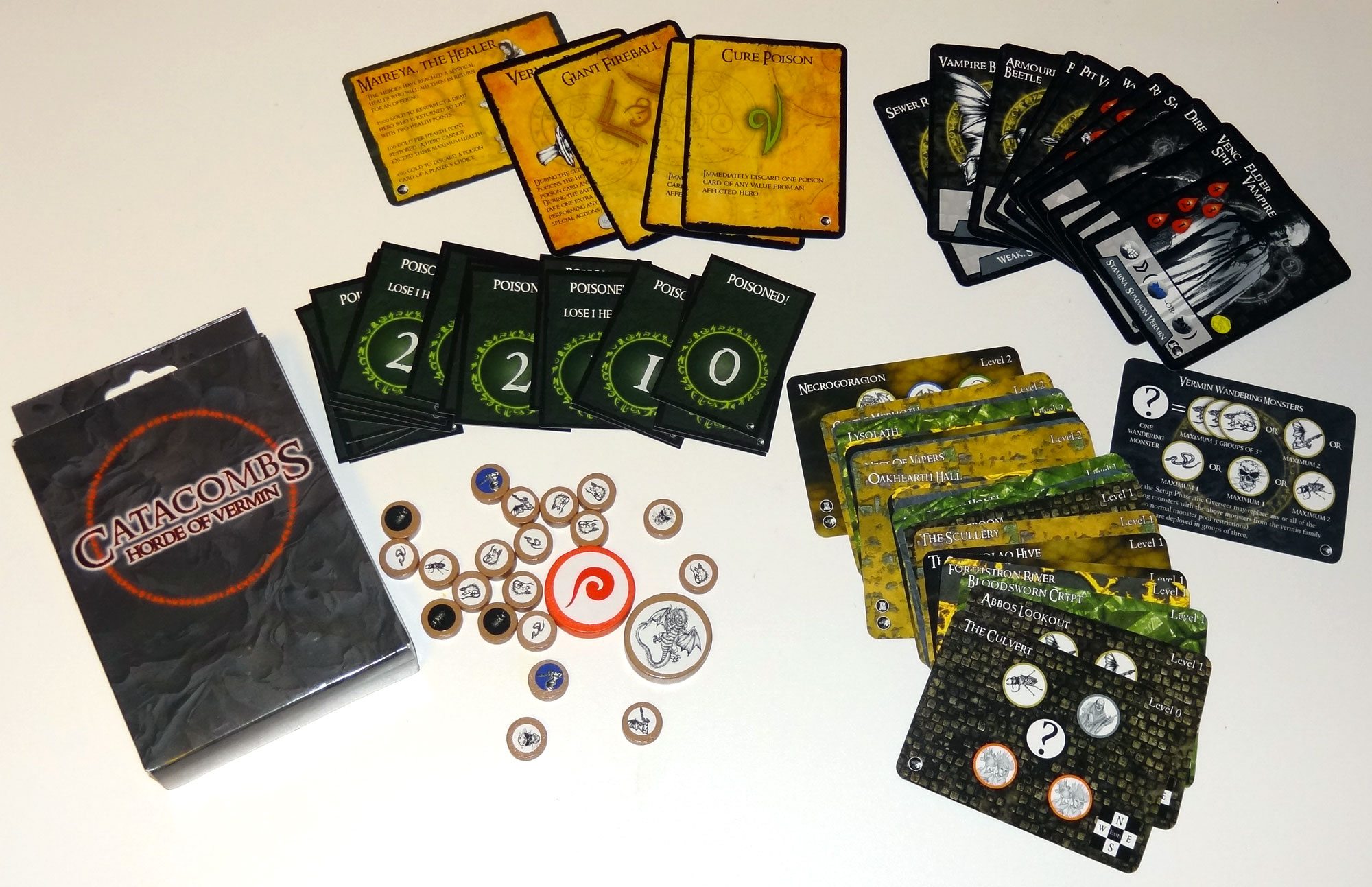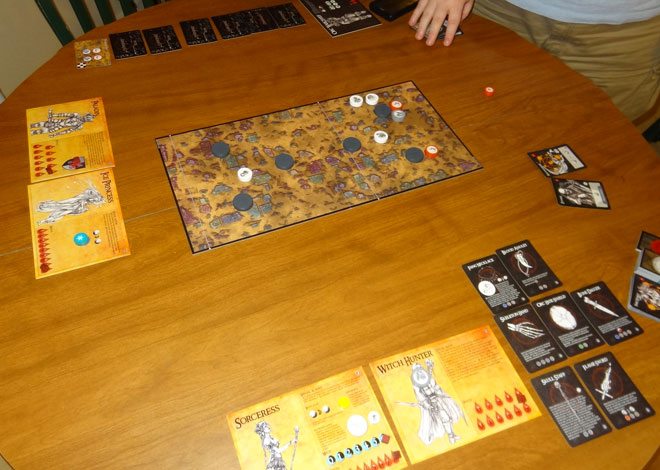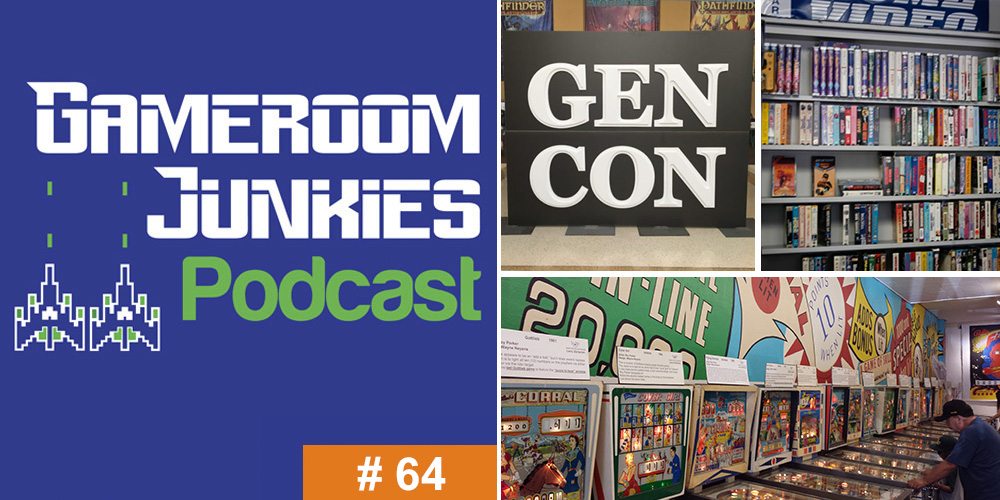
Overview: Catacombs, the disc-flicking dungeon crawl, was my pick for 2011 Game of the Year. It’s time to revisit the dungeons, which have grown larger and more dangerous with two expansions: Cavern of Soloth and Hordes of Vermin. (There’s also a mini-expansion called Dark Passageways but I haven’t tried that one out yet.) Note: both of these are expansions, and require the original base set to play.
Players: 2 to 5
Ages: 12 and up
Playing Time: 1 to 2 hours (the box says 30-60 minutes, but usually it’ll take longer, especially with more players)
Retail: Soloth: $36.99, Vermin: $35.99
Who Will Like It? If you liked the original, these are both worth adding to your collection — Soloth adds more Catacomb Lords and Heroes, and Vermin (despite the small box) boosts some of the existing monsters from the base set and Soloth.

Components:
Caverns of Soloth:
- 7 artifact cards
- 18 item cards
- 12 monster cards
- 29 room cards
- 10 small currency cards
- 41 wooden discs
- 7 red wooden cubes (health trackers)
- 8 player mats (4 Heroes, 4 Catacombs Lords)
- stickers
Hordes of Vermin:
- 3 spell cards
- 1 item card
- 12 monster cards
- 25 room cards
- 1 reference card
- 21 small poison cards
- 22 wooden discs
- stickers
As with the original set, you’ll have to take the time to put stickers on all the wooden discs (usually on both sides), and you’ll want to follow the instructions pretty carefully to be sure that you get the right stickers on the right discs. The Hordes of Vermin stickers were a little trickier as the discs are much smaller:

I’m still not a huge fan of the illustration style on the cards and playmats, which is the same as the original, but the gameplay more than compensates for that. The cards are the same type as the original as well, matte-finished and maybe on the slightly flimsy side, but you don’t do a whole lot of shuffling past the initial setup.
Gameplay:
The two expansions don’t change the basic rules of the game (for that, read my review of the original): they add new effects, monsters, and so on.
Cavern of Soloth:
This is the heftier of the two expansions, adding a new band of heroes, four more Catacombs Lords for the Overseer to choose from, and a host of new monsters. Along with those come new Room cards that show the additional monsters, plus item cards geared toward these new heroes.
First off, the new bad guys:

First, the new bosses have adjustable starting health — some of the blood droplets on the playmats are purple-pink, giving them additional health if you want to increase the difficulty for the heroes.
The Shapeshifter does just that: you shuffle a stack of six fairly nasty monsters, and at the start of each turn you draw one from the stack — the Shapeshifter then gets to perform a melee attack, followed by the standard attacks of the monster chosen (along with any special abilities). The Shapeshifter doesn’t have a lot of really strong minions, but maybe he doesn’t need them.
The Hydra does have some nasty minions, but its special power is that its attacks get worse as it loses health. And they start strong. At 6 or more health, it can do a melee, then a critical melee (that does extra damage). With 4 or 5 health, it does a four-shot melee-fireball combo. And then at 3 or less health, it does a regular melee followed by two critical melees. This is not a nice creature.
The Queen of the Underworld has three spirit minions, represented by the little tiny yellow missile discs. They can be used to push things around but don’t do damage — but they can only be temporarily destroyed if you push them entirely off the board. And once all three have been destroyed, they come right back, surrounding the Queen again. On each turn, the Queen moves all of the spirit minions, then can teleport by swapping locations with one of them, and then does two melee shots from that location. On top of this, any Heroes she kills become Shades.
The Orc Warchief gets several of the green monsters as minions — they all have at least two hit points and some of them have extra nasty abilities. But what makes the Warchief especially troublesome for the Heroes is his special ability: if he inflicts damage on the Heroes, then one of his minions gets an extra action. In addition, if he kills a Hero, then all of his minions regenerate (get one hit point back) and each of them gets another action. Played well, the Warchief could pretty much power through several Heroes in one turn.

As for the regular monsters, there are several new abilities that come into play. Corrosion gives a monster the chance to destroy one of your items. Evasion is like the Thief’s ability — after hitting somebody, the monster can use one non-damaging shot to run away. Incorporeal means that it cannot be killed except by shoving it completely off the board. Mounted Unit (like the Orc Wolf Rider) means that when you kill it, you’ve only killed the mount — then the Orc is placed on the board and keeps fighting. Resurrection means just that – it keeps coming back, until you’ve killed off all the other monsters. Slave Master lets you give another monster a second turn. Suppression keeps Heroes from using special actions and abilities. Touch of Decay lets you regenerate other monsters when you hit a Hero. Volcanism lets the monster place Fire Walls in the room. Finally, Wellspring gives other monsters in the room the ability to regenerate, making them much harder to kill.

The four new Heroes parallel the four original Heroes, so you can mix-and-match, but you should stick with the four different classes.
The Witch Hunter replaces the Thief: when he kills monsters, he keeps them on his card and can turn them in at the end of a room to craft Artifacts. These are various items and weapons which make him more powerful as the game continues — but only if he manages to make the kill. Each Artifact requires certain combinations of different colors of monsters killed — and if you don’t use them up and the Overseer needs them to populate a room, then you lose them.
Here are a few examples of the Witch Hunter’s artifacts:

The Sorceress replaces the Wizard. Rather than a deck of one-time-use spells, she starts with six magic points and can spend them on any turn to cast her spells as many times as she wants. She can shoot two missiles (but is then incapacitated for a turn), open a portal to swap the locations of two Heroes, or change into an alternate tiny form. If she runs out of magic points, she can also sacrifice health to cast spells. This makes her more flexible than the wizard, but also a bit harder to use well.
The Ice Princess replaces the Elf. She has a melee/missile combination, and the missile is an ice shard which freezes monsters instead of damaging them. The freezing can be useful, but you have to time it properly or else they’ll interfere with your other Heroes’ attacks.
Finally, there’s the Paladin, who replaces the Barbarian. He’s your melee fighter with lots of health. But instead of the Rage ability, the Paladin has 2 points of armor which recharges after every room. Using the armor not only protects the Paladin’s health but also negates the nasty effects of the monster that hit him.

The new items, as in the original, are a mix of Hero-specific items and ones that can be wielded by any Hero. Several of the items are one-time-use, so they’re powerful if you choose the right time to use them. There’s also a Dwarf Miner, a mercenary with five health that will fight for you as long as you pay him each room. Otherwise, he leaves. The items can be purchased when you enter the Merchant room near the beginning of the dungeon.
The final change in Cavern of Soloth is the Altar of Soloth room, which can replace the Healer right before you fight the Catacomb Lord. At the Altar, the Heroes may spend 500 gold to see the next Item card and take it. Or, they can spend another 500 to replace it with the next card, and so on — but they can only buy the last Item they see. It’s another chance to get something useful right before the big fight, but it does mean you can’t buy back any health.

Hordes of Vermin is a smaller expansion — it doesn’t have the new Catacombs Lords or Heroes, and there are fewer wooden discs (and smaller ones), but it makes up for it in sheer nastiness. The Heroes get a few extras, like new spells for the Wizard (Cure Poison and Giant Fireball) and the Vermin Blade which poisons the user, but mostly this is about giving the Overseer some new tools.
The biggest change is the addition of the new poison shot modifier. Green icons on the monster cards indicate a poison shot — if a Hero is hit with a poison shot, then they draw a small poison card from the deck. Some of these inflict damage, but most of them have a number on them indicating the amount of poison affecting the hero. If the total on accumulated poison cards adds up to the starting health of the Hero, then they’ve been overwhelmed by poison and they die. The Wizard gains a Cure Poison spell (two uses) and the Healer can also cure poison … if you last that long.
There’s also a new fear shot modifier, with a black icon. When a Hero is hit by a fear shot, then the Overseer gets to flick the Hero disc one more time (not doing any damage), which simulates the Hero running away in fear — possibly into range of other monsters.
Some of the monsters also have caps on the gold they reward, and the sewer rats provide no reward at all, so the Heroes have to work hard to earn gold. In addition, the vermin can be used as wandering monsters instead of the ones listed on the Catacomb Lord card. There are some variant monsters that can be used in place of monsters from the base set and Cavern of Soloth. For instance, the Dread Scorpion now has a poisonous sting, as does the Venomous Spider. These variant monsters are recommended for advanced Hero players (or to help balance a less-experienced Overseer).
Finally, there are some new monster abilities: Lethal makes the Hero draw two poison cards instead of one. Some monsters have more than two hit points, and instead have a health tracker on the card. Summon Vermin lets the monster summon five sewer rats — they appear in the Hero Start Zone, and can move on the same turn they were summoned. Swarm lets monsters crawl all over the target (stacking the discs on top). If you get three Swarm monsters onto a Hero, then the Overseer can choose to damage the hero or poison them. And one of my favorites: Devourer. The Remorhaz, for instance, can devour Heroes by striking them twice consecutively. The Hero has been swallowed and is placed on the creature card, and cannot take any actions. But they’re not dead yet — if you destroy the monster, then the heroes are released and returned to the board where the monster died. However, if at any time all the Heroes are incapacitated, dead, or swallowed, then the Overseer wins.

Conclusion:
If you like the original Catacombs, the Cavern of Soloth expansion offers a lot of bang for your buck. It’s nearly as big as the original game — the only things it lacks to be a stand-alone game are the game boards and pillar discs. Of the new Heroes, the Paladin is probably easier than the Barbarian. The Ice Princess seems a little less useful (or maybe harder to use) than the Elf. The Sorceress is also a little trickier than the Wizard — although you can use her spells multiple times, you’ll find yourself running out of Magic Points, and I like the Wizard’s spells better. The Witch Hunter can be very powerful, though, and I like him better than the Thief, who just gets you extra gold: his Artifacts can make him a formidable fighter if you can build them in time.
The new Catacomb Lords are very impressive, too, and the adjustable starting health lets you handicap the more experienced player to help balance the game. While the host of new abilities may have you consulting the rulebook more often, they do add a lot of variety to the types of attacks (and thus the types of strategies) players can employ.
Hordes of Vermin might be a slightly harder sell: it has nearly the same retail price, though chances are you can find it for less. It comes in a pocket-sized box and simply doesn’t look as impressive. Looks aren’t everything, though, and the vermin can make things very difficult for the heroes quite early. Again, it adds a host of new abilities, mostly for the Overseer this time. It’s definitely a keeper, but I’ll probably save it for when playing against pretty experienced Heroes. I’m not sure that new players would be able to handle the vermin swarms.

I still don’t get to play Catacombs as often as I’d wish — I even took all 3.5 pounds of it to PAX with me this year but never got the opportunity to break it out — but I enjoy it every time I do. There’s just something immensely satisfying about flicking things across a board at each other, and if you haven’t tried it yet you should give it a shot!
Disclosure: GeekDad received review copies of these games. All photos by Jonathan H. Liu



